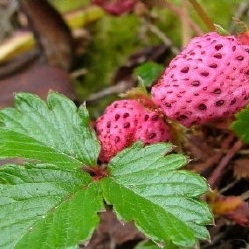A shrub. It has a stout rootstock. The leaves have 3 leaflets. The leaflets do not have stalks. They are 0.5-3.5 cm long by 0.3-2.5 cm wide. They are oval and with teeth along the edge. Underneath there are hairs along the veins. The flowers are white. They occur on 1 or 2 flowered stalks. The fruit is round and red.

